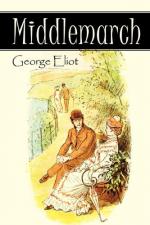At Middlemarch in those times a large sale was regarded as a kind of festival. There was a table spread with the best cold eatables, as at a superior funeral; and facilities were offered for that generous-drinking of cheerful glasses which might lead to generous and cheerful bidding for undesirable articles. Mr. Larcher’s sale was the more attractive in the fine weather because the house stood just at the end of the town, with a garden and stables attached, in that pleasant issue from Middlemarch called the London Road, which was also the road to the New Hospital and to Mr. Bulstrode’s retired residence, known as the Shrubs. In short, the auction was as good as a fair, and drew all classes with leisure at command: to some, who risked making bids in order simply to raise prices, it was almost equal to betting at the races. The second day, when the best furniture was to be sold, “everybody” was there; even Mr. Thesiger, the rector of St. Peter’s, had looked in for a short time, wishing to buy the carved table, and had rubbed elbows with Mr. Bambridge and Mr. Horrock. There was a wreath of Middlemarch ladies accommodated with seats round the large table in the dining-room, where Mr. Borthrop Trumbull was mounted with desk and hammer; but the rows chiefly of masculine faces behind were often varied by incomings and outgoings both from the door and the large bow-window opening on to the lawn.
“Everybody” that day did not include Mr. Bulstrode, whose health could not well endure crowds and draughts. But Mrs. Bulstrode had particularly wished to have a certain picture—a “Supper at Emmaus,” attributed in the catalogue to Guido; and at the last moment before the day of the sale Mr. Bulstrode had called at the office of the “Pioneer,” of which he was now one of the proprietors, to beg of Mr. Ladislaw as a great favor that he would obligingly use his remarkable knowledge of pictures on behalf of Mrs. Bulstrode, and judge of the value of this particular painting—“if,” added the scrupulously polite banker, “attendance at the sale would not interfere with the arrangements for your departure, which I know is imminent.”




